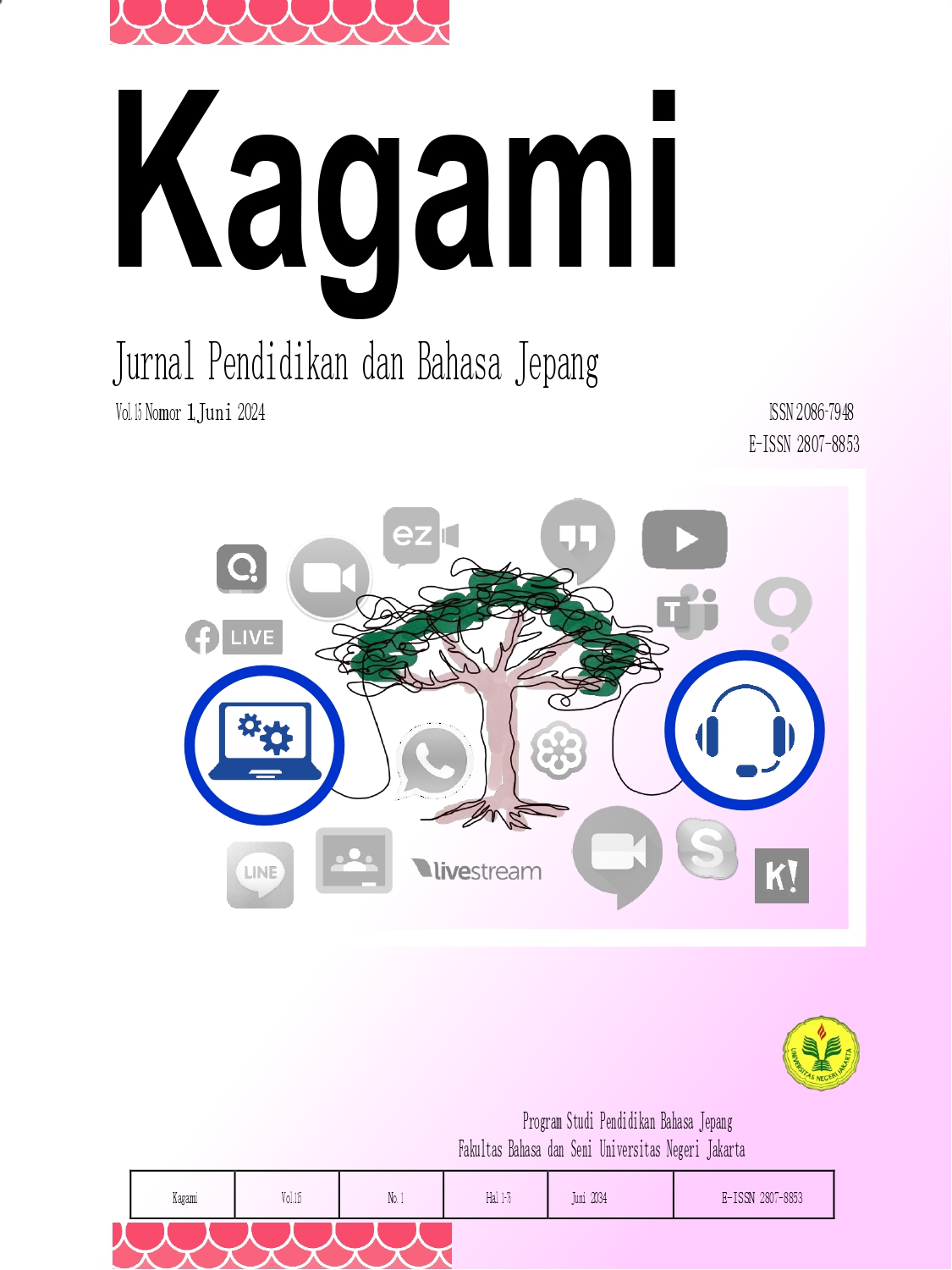PEMBENTUKAN GYARUGO DALAM MANGA MY DRESS UP DARLING
English
DOI:
https://doi.org/10.21009/kagami.151.03Keywords:
gyarugo, wakamono kotoba, manga, wordAbstract
The term "Gyaru" refers to a group of Japanese women who are distinguished by their unique fashion style, as well as their language, which is known as "Gyarugo." Gyarugo is one of the pioneers of the term wakamono kotoba, which is frequently employed by young Japanese people.
This study aims to explain the use of gyarugo in the manga 'My Dress Up Darling', which focuses on the main heroine Marin Kitagawa, which is reviewed based on the formation of wakamono kotoba theory Yonekawa (1996). The data source for this study is volume 1 (chapters 1 to 7) of the manga My Dress Up Darling by Shinichi Fukuda, published in the Young Gangan manga magazine on 19 January 2018. The research method employed in this study is qualitative, while the technique utilised is that of listening and note-taking. The results obtained are the use of 48 gyarugo, as expressed by Marin Kitagawa, which consists of 4 Shakuyou, 39 Shouryaku, 1 Touchi, 5 and Doushi no hasei.
References
Alwasilah & A. Chaedar (1993). Linguistik: Suatu Pengantar. Bandung: Angkasa
Azzahra, A. F. (2020). Analisis Struktur Singkatan Kata (Shouryaku) Dalam Media Online Twitter Unggahan Takahashi Minami (AKB48) ツイッターオンラインメディアにおける高橋みなみ (AKB48) が アップロードされた単語省略形の構造分析 (Doctoral dissertation, UNIVERSITAS AIRLANGGA).
Billyarta, T. M., & Anjarningsih, H. Y. (2024, January). Translation ideology analysis in the English and Indonesian subtitles of Hige wo Soru. Soshite Joshikousei wo Hirou. on Muse Youtube channels. In Forum for Linguistic Studies (Vol. 6, No. 1).
Fadhillah, V. (2015). Struktur Dan Makna Gyarugo Pada Shibuya Go Jiten 09-10 (Doctoral dissertation, Universitas Airlangga).
Handayani, W. R. (2021). Bahasa Gaul Remaja Perempuan Jepang (Gyarugo) Analisis Bentuk, Makna, Identitas, dan Relasi Gender (Doctoral dissertation, Universitas Gadjah Mada)
Kartika, D., & Jumanto, J. (2024). Refusal Politeness within Anime: How the Japanese Youngsters Learn to Refuse. International Journal of Society, Culture & Language, 12(1), 427-440.
Kridalaksana & Harimurti. (1993). Kamus Linguistik Edisi Ketiga. Jakarta : PT. Gramedia Pustaka Utama.
Laili, Nurul. (2012). Penggunaan Wakamono Kotoba Remaja Jepang. Jurnal Diglossia, 3(2)
Putri, A. I. M., Philiyanti, F., & Prasetio, V. M. (2023). Teknik Penerjemahan Berdasarkan Peristiwa Tutur Bahasa Slang Wanita dalam Anime Oshiete! Gyaruko chan (2016) Karya Kenya Suzuki. In Prosiding Seminar Nasional Kolaborasi Akademik Dosen-Mahasiswa (Vol. 1, No. 1, pp. 346-356).
Richards, J. C., Platt, J., & Weber, H. (1985). Longman Dictionary of Applied Linguistics. London: Longman Group UK Limited.,
Sudjianto. (2007). Bahasa Jepang dalam Konteks Sosial dan Kebudayaannya. https://www.academia.edu/9382571/Bahasa_Jepang_dalam_Konteks_Sosial_dan_Kebudayaannya.html
Susanty, R. A. R., & Prasetyo, J. (2017) Bahasa Gyaru dalam Cuitan Akun Twitter Anggota Komunitas Gyaru: Konsentrasi pada Pembentukan Kata-Kata dan Shūjoshi.
https://www.academia.edu/download/89367029/230780474.pdf.
Tanaka, H. (1996). An invitation to sociolinguistics (1st ed.). Nagoya: Minerva.
Yonekawa, A. (1996). Gendai Wakamono Kotoba Ko (若者言葉考). Tokyo: Library Maruzon
Downloads
Published
Issue
Section
License
Copyright (c) 2024 Ikbal Ramdan Suhendar, Mohammad Ali

This work is licensed under a Creative Commons Attribution 4.0 International License.





